- Where castle history meets spiritual calm
- Hyogo Prefectural Museum of History (兵庫県立歴史博物館)
- Nozato Gate Ruins (野里門跡)
- Nakabori Site
- Himeji Jinja (姫路神社)
- North Segakushi Gate Ruins (北勢隠門跡)
- Segakushi Bailey (勢隠曲輪)
- Sagi-no-Shimizu (鷺の清水)
- Shimizu Gate Ruins (清水門跡)
- Otokoyama Haisuiike Park (Water Reservoir Park)
- Otokoyama Senhime Tenmangū (男山千姫天満宮)
- Sengoku no Komichi (千姫の小径)
- Ichinohashi Gate Ruins (市ノ橋門跡)
- Statue of Princess Sen (Senhime)
- Kōkoen Garden
- Remains of South Segakushi gate
- Kuruma Gate Ruins (車門跡)
- Uzumi Gate Ruins (埋門跡)
- Kumataka-mon Gate Site
- Nakanomon Gate Site
- Nakabori (Middle Moat) Remains (中濠跡)
- Sōja Gate Ruins (総社門跡)
- Himeji Castle Map
- Related Articles on Himeji Castle
- 🔙 Return to the Warload Page
Where castle history meets spiritual calm
Area 6 invites you to explore the tranquil outer edges of Himeji Castle, where history blends seamlessly with gardens, shrines, and quiet ruins.
Visit the Hyogo Prefectural Museum of History for deeper context, stroll through the refined beauty of Kōkoen Garden, and pay respects at the Otokoyama Senhime Tenmangū Shrine, dedicated to Princess Sen.
Along the way, you’ll discover remnants of lost gates, hidden moats, and atmospheric paths like Sengoku no Komichi—each offering a peaceful reflection on the castle’s legacy and its cultural surroundings. This area is ideal for those seeking a slower pace and a deeper connection to the spirit of Himeji.
Hyogo Prefectural Museum of History (兵庫県立歴史博物館)

⭐ Recommended Rating
Historical Significance: ☆☆☆
Visual Appeal: ☆☆
Experiential Value: ☆☆☆
The Hyogo Prefectural Museum of History, located northeast of Himeji Castle, was established in April 1983 to deepen residents’ understanding of local history and contribute to education and culture. Designed by renowned architect Kenzo Tange, the building’s architecture reflects the aesthetics of Himeji Castle, featuring white walls and stone-like facades. The museum underwent significant renovations, reopening in April 2007 and again in April 2023 after extensive facility upgrades. Its exhibitions cover a broad spectrum, from ancient times to the modern era, focusing on the history of Hyogo Prefecture, including regions formerly belonging to the provinces of Settsu, Harima, Tajima, Tamba, and Awaji. Notably, the museum houses a collection exceeding 200,000 items, including an Important Cultural Property—a Kamakura-period painting of the Buddha’s parinirvana—and five Prefectural Tangible Cultural Properties. Visitors can explore various exhibits, such as the “Anatomy of Himeji Castle,” which showcases the East Main Pillar of the castle’s main keep and the shachihoko ornaments restored during the Showa era renovations. The museum also offers interactive experiences, including virtual dressing in traditional attire and hands-on exhibits, making it an engaging destination for all ages.
| Year Established | 1983 |
|---|---|
| Architect | Kenzo Tange |
| Structure & Features | Modern design reflecting Himeji Castle aesthetics; extensive exhibition spaces |
| Renovation History | Major renovations in 2007 and 2023 |
| Current Status | Operational with updated facilities and exhibitions |
| Damage or Destruction | None |
| Cultural Designation | Houses nationally and prefecturally designated cultural properties |
🗺 Address:68 Honmachi, Himeji, Hyogo Prefecture, Japan
🚶 Access
Approx. 5-minute walk (350m) from Kisai-mon Gate Site
⏳ Suggested Visit Duration
Quick Highlights: approx. 45 minutes
In-Depth Exploration: approx. 2 hours
📍 Highlights
- Anatomy of Himeji Castle: Exhibits featuring the East Main Pillar and shachihoko ornaments from the castle’s main keep.
- Encyclopedia of Japanese Castles: Scale models of Japan’s 12 surviving castle keeps and the Edo Castle’s third-generation tenshu.
- Interactive Experiences: Virtual dressing in traditional attire and hands-on exhibits for all ages.
📌 Trivia
- Architectural Design: The museum’s design mirrors Himeji Castle, with white walls and stone-like facades.
- Extensive Collection: Houses over 200,000 items, including nationally and prefecturally designated cultural properties.
- Educational Role: Serves as a center for learning about Hyogo Prefecture’s rich history and culture.
Nozato Gate Ruins (野里門跡)
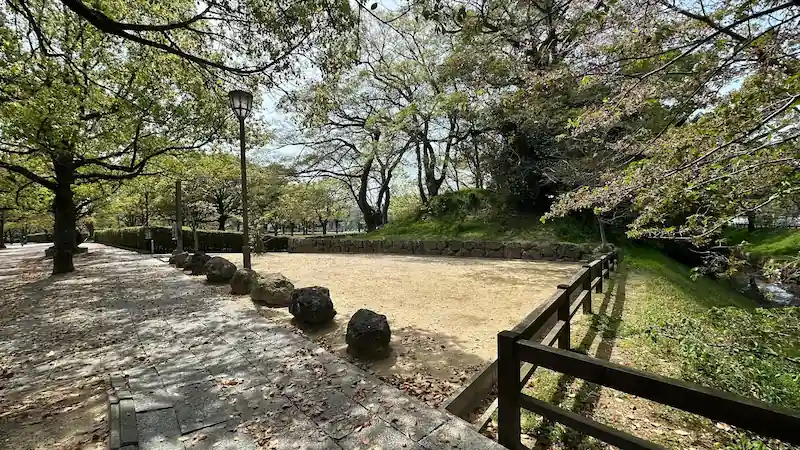
⭐ Recommended Rating
Historical Significance: ☆☆
Visual Appeal: ☆
Experiential Value: ☆
The Nozato Gate Ruins mark the former location of the northern entrance to Himeji Castle’s inner castle town. Named after the adjacent Nozato-machi, a district historically known for its metalworking artisans, the location is believed to have served as an entrance even before the 1581 renovations commissioned by Toyotomi Hideyoshi. Strategically positioned along the Tajima Kaido—a vital highway traversing Nozato-machi—the gate served as a critical point of access and defense. Architecturally, it featured a complex design with two double-doored gateways separated by an inner courtyard. The larger inner gate, oriented northward, was topped with a storehouse, while the east-facing outer gate stood at a right angle, creating a zigzag configuration to thwart direct assaults. Today, while much of the original structure has been lost to modern development, remnants of the stone walls remain, offering a glimpse into the castle’s defensive ingenuity.
| Item | Content |
|---|---|
| Year Built | Early 17th century (Edo period) |
| Builder | Ikeda Terumasa |
| Structure/Features | One of the outer gates of Himeji Castle, providing access to the castle from the northwestern direction. |
| Renovation/Restoration | None |
| Current Status | Ruins remain; only stone foundations are visible. |
| Destruction/Damage | Gate structure no longer exists. |
| Cultural Property Designation | None |
| Remarks | Served as a checkpoint controlling access to the castle from the Nozato area. |
🗺 Address:68 Honmachi, Himeji, Hyogo Prefecture, Japan
🚶 Access
Approx. 4-minute walk (300m) from Hyogo Prefectural Museum of History (兵庫県立歴史博物館)
⏳ Suggested Visit Duration
Quick Highlights: approx. 10 minutes
In-Depth Exploration: approx. 20 minutes
📍 Highlights
- Stone Foundations: Observe the remaining stone structures that outline the gate’s original layout.
- Historical Context: Learn about the gate’s role in the castle’s defense and its connection to Nozato-machi’s metalworking heritage.
- Scenic Surroundings: Enjoy a walk along the nearby moat and cherry blossom-lined paths, especially picturesque in spring.
📌 Trivia
- Strategic Design: The gate’s zigzag configuration was a tactical feature to impede enemy advances.
- Modern Encroachment: Much of the original gate area is now beneath modern roads and buildings, highlighting the challenges of urban preservation.
- Historical Signage: Informational signs at the site provide insights into the gate’s history and significance.
Nakabori Site
⭐ Recommended Rating
Historical Significance: ☆☆
Visual Appeal: ☆
Experiential Value: ☆
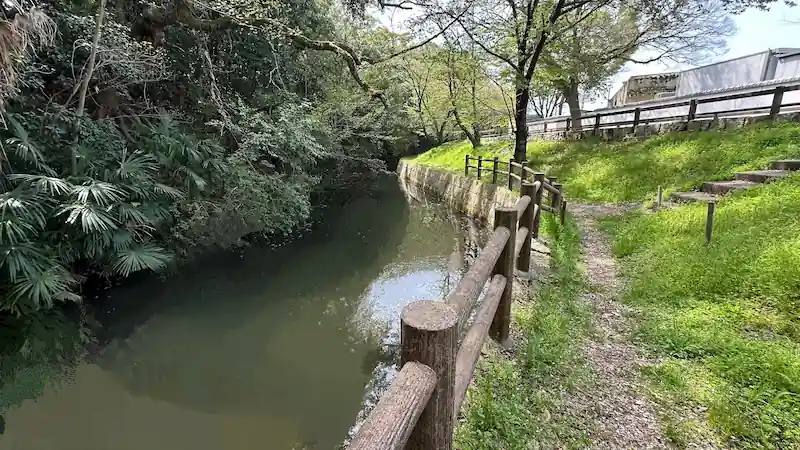
The Nakabori, or Middle Moat, was an integral part of Himeji Castle’s triple-moat defense system, which included the inner (uchibori), middle (nakabori), and outer (sotobori) moats. Constructed during the early 17th century under the direction of Ikeda Terumasa, the Nakabori extended approximately 4.3 kilometers, encircling the castle’s core structures and providing an additional layer of protection. While much of the Nakabori has been lost to urban development, certain segments remain visible today, offering insight into the castle’s original defensive layout. Informational signage at these sites provides historical context and aids visitors in visualizing the moat’s former expanse.
| Item | Content |
|---|---|
| Year Built | Early 17th century (Edo period) |
| Builder | Ikeda Terumasa |
| Structure/Features | Part of the castle’s moat system, serving as an inner defensive moat. |
| Renovation/Restoration | None |
| Current Status | Partially preserved; some sections have been filled in or altered. |
| Destruction/Damage | Sections lost due to urban development. |
| Cultural Property Designation | None |
| Remarks | Originally designed to enhance the castle’s defensive capabilities. |
🗺 Address: 68 Honmachi, Himeji, Hyogo Prefecture
🚶 Access
Approx. 2-minute walk (180m) from Nozato Gate Ruins (野里門跡)
⏳ Suggested Visit Time
Quick Stop: Approx. 10 minutes
In-Depth Exploration: Up to 30 minutes
📍 Highlights
- Remaining Moat Segments: Visible portions of the Nakabori provide a tangible connection to the castle’s historical defenses.
- Informational Signage: Educational panels offer context and historical background on the moat’s construction and purpose.
- Seasonal Scenery: The surrounding areas offer pleasant views, especially during cherry blossom season.
📌 Trivia
- Defensive Strategy: The triple-moat system exemplifies the strategic military architecture of Japanese castles during the Edo period.
- Urban Development Impact: Much of the Nakabori was filled in during the modernization of Himeji, reflecting the challenges of preserving historical sites amid urban expansion.
- Cultural Significance: The remaining segments of the Nakabori contribute to Himeji Castle’s designation as a Special Historic Site and UNESCO World Heritage Site.
Himeji Jinja (姫路神社)
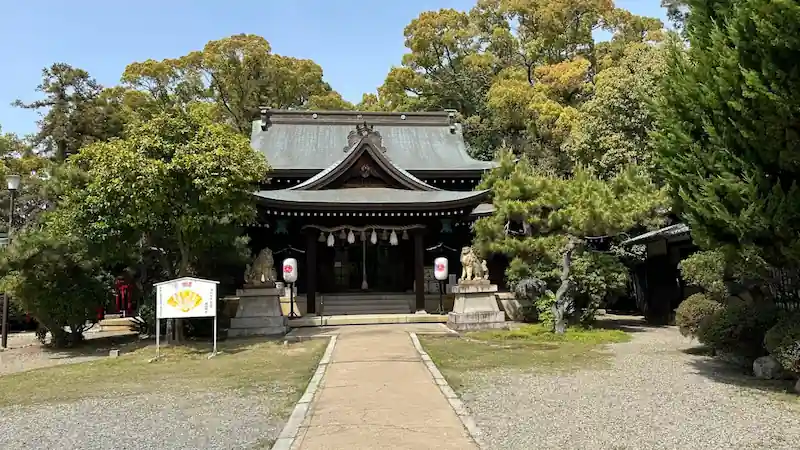
⭐ Recommended Rating
Historical Significance: ☆☆
Visual Appeal: ☆☆☆
Experiential Value: ☆☆
Himeji Jinja is a Shinto shrine located adjacent to the grounds of the UNESCO World Heritage Site, Himeji Castle, in Hyogo Prefecture, Japan. Established in 1879 (Meiji 12), the shrine enshrines Sakai Masachika, the founder of the Sakai clan, who served as the last feudal lords of the Himeji Domain. The shrine was founded by former retainers and prominent townspeople of the Himeji Domain to honor their former lord. In 1927 (Showa 2), it was relocated to its current location in the northeastern part of Himeji Castle, an area traditionally considered to ward off evil spirits. The shrine’s architecture harmonizes with the surrounding castle structures, featuring traditional design elements. Visitors can also find within its precincts the Sunno Shrine, dedicated to Kawai Sunno, a notable figure in the development of the Himeji Domain, and the Iwakura Inari Shrine, dedicated to the deity Ukanomitama. Himeji Jinja serves as a place of worship and cultural significance, offering a serene environment for reflection amidst the historical backdrop of Himeji Castle.
| Year Established | 1879 (Meiji 12) |
|---|---|
| Founder | Former retainers and townspeople of the Himeji Domain |
| Structure & Features | Traditional shrine architecture; includes Sunno Shrine and Iwakura Inari Shrine within its precincts |
| Restoration History | Relocated to current location in 1927 (Showa 2) |
| Current Status | Active place of worship within Himeji Castle grounds |
| Destruction or Damage | None reported |
| Cultural Designation | Part of the Himeji Castle UNESCO World Heritage Site |
🗺 Address:83 Honmachi, Himeji, Hyogo Prefecture, Japan
🚶 Access
Approx. 14-minute walk (1000m) from Nakabori Site
⏳ Suggested Visit Duration
Quick Highlights: approx. 20 minutes
In-Depth Exploration: approx. 45 minutes
📍 Highlights
- Main Shrine Building: Traditional architecture harmonizing with Himeji Castle’s aesthetics.
- Sunno Shrine: Dedicated to Kawai Sunno, a key figure in the domain’s development.
- Seasonal Scenery: Beautiful cherry blossoms in spring and vibrant foliage in autumn.
📌 Trivia
- Historical Significance: Established to honor the Sakai clan, the last feudal lords of Himeji.
- Strategic Location: Situated in the northeastern part of Himeji Castle, traditionally considered to ward off evil spirits.
- Architectural Harmony: Design elements reflect the aesthetics of the surrounding castle structures.
North Segakushi Gate Ruins (北勢隠門跡)
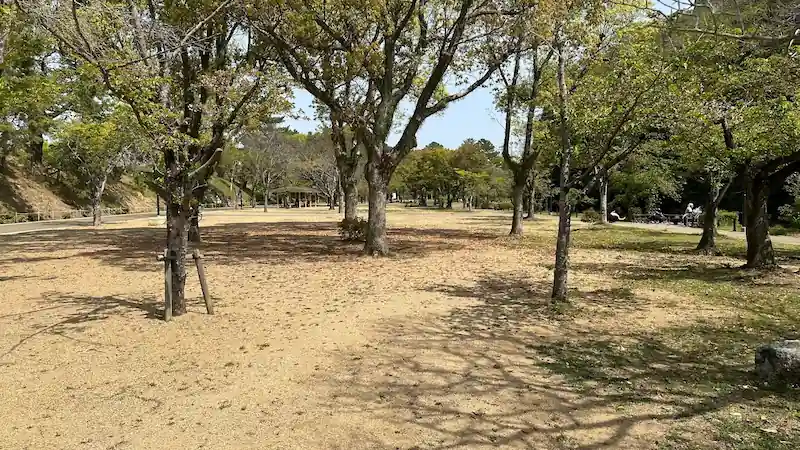
⭐ Recommended Rating
Historical Significance: ☆☆
Visual Appeal: ☆
Experiential Value: ☆
The North Segakushi Gate Ruins mark the former location of one of the northern entrances to Himeji Castle’s inner compounds. The term “Segakushi” refers to a concealed or hidden area, indicating the gate’s strategic purpose in providing a discreet access point. Situated in the area now known as Himeyama Park, the gate was part of the castle’s complex defensive network. While the original gate structure no longer exists, remnants of the stone walls remain, offering insights into the castle’s architectural ingenuity. Visitors can observe these ruins and appreciate the historical significance of the site.
| Year Built | Early 17th century |
|---|---|
| Builder | Ikeda Terumasa |
| Structure & Features | Concealed gate with stone walls; part of the castle’s northern defense |
| Restoration History | Stone wall repairs conducted in 1995 |
| Current Status | Stone foundations remain; gate structure lost |
| Destruction or Damage | Original gate dismantled; area affected by modern development |
| Cultural Designation | Part of Himeji Castle, a UNESCO World Heritage Site |
🗺 Address:68 Honmachi, Himeji, Hyogo Prefecture, Japan
🚶 Access
Approx. 3-minute walk (210m) from Himeji Jinja (姫路神社)
⏳ Suggested Visit Duration
Quick Highlights: approx. 10 minutes
In-Depth Exploration: approx. 20 minutes
📍 Highlights
- Stone Foundations: Observe the remaining stone structures that outline the gate’s original layout.
- Historical Context: Learn about the gate’s role in the castle’s northern defense system.
- Scenic Surroundings: Enjoy a walk through Himeyama Park, especially picturesque during cherry blossom season.
📌 Trivia
- Concealed Design: The gate’s name, “Segakushi,” implies its hidden nature, serving as a discreet entry point.
- Modern Encroachment: Much of the original gate area is now beneath modern roads and buildings, highlighting the challenges of urban preservation.
- Restoration Efforts: Stone wall repairs were conducted in 1995 to preserve the remaining structures.
Segakushi Bailey (勢隠曲輪)

⭐ Recommended Rating
Historical Significance: ☆☆
Visual Appeal: ☆
Experiential Value: ☆
Segakushi Bailey is a narrow, elongated area located on the northern side of Himeji Castle’s main keep. Designed as a defensive buffer, it served to impede direct access to the central compound. The term “Segakushi” implies a concealed or hidden area, reflecting its strategic purpose. Flanked by earthworks and moats, the bailey was accessible through the North and South Segakushi Gates. Today, the area is part of Himeyama Park, offering visitors a serene environment with remnants of historical structures. The park is especially picturesque during cherry blossom and autumn foliage seasons.
| Year Built | Early 17th century |
|---|---|
| Builder | Ikeda Terumasa |
| Structure & Features | Narrow bailey with earthworks and moats; served as a defensive buffer |
| Restoration History | Stone wall repairs conducted in 1995 |
| Current Status | Part of Himeyama Park; remnants of earthworks and stone walls remain |
| Destruction or Damage | Original structures dismantled; area affected by modern development |
| Cultural Designation | Part of Himeji Castle, a UNESCO World Heritage Site |
🗺 Address:68 Honmachi, Himeji, Hyogo Prefecture, Japan
🚶 Access
Approx. 1-minute walk (80m) from North Segakushi Gate Ruins (北勢隠門跡)
⏳ Suggested Visit Duration
Quick Highlights: approx. 15 minutes
In-Depth Exploration: approx. 30 minutes
📍 Highlights
- Earthworks and Moats: Observe the remaining defensive structures that outline the bailey’s original layout.
- Historical Context: Learn about the bailey’s role in the castle’s defense system.
- Scenic Surroundings: Enjoy a walk through Himeyama Park, especially picturesque during cherry blossom and autumn foliage seasons.
📌 Trivia
- Concealed Design: The bailey’s name, “Segakushi,” implies its hidden nature, serving as a discreet defensive buffer.
- Modern Encroachment: Much of the original bailey area is now part of Himeyama Park, highlighting the challenges of urban preservation.
- Restoration Efforts: Stone wall repairs were conducted in 1995 to preserve the remaining structures.
Sagi-no-Shimizu (鷺の清水)
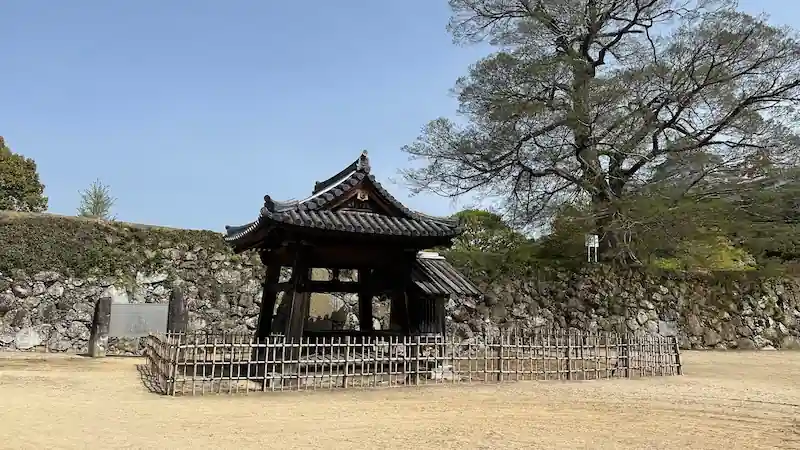
⭐ Recommended Rating
Historical Significance: ☆☆
Visual Appeal: ☆☆
Experiential Value: ☆
Sagi-no-Shimizu, translating to “Heron’s Spring,” is a historic well situated within the grounds of Himeji Castle in Hyogo Prefecture, Japan. Recognized as one of the “Harima Jūsui” (Ten Famous Waters of Harima), it has been esteemed for its pure and flavorful water since the Muromachi period. The well’s water was reputedly valued for its clarity and is said to have been used in tea ceremonies, a testament to its quality and cultural significance. Due to its location within the castle, commoners were prohibited from accessing it directly; instead, they utilized the spring water as it flowed into the nearby Semba River. The well features a unique construction: a stone-lined outer structure measuring approximately 2.8 meters east-west and 6 meters north-south, with a depth of 2.5 meters. At its center lies a wooden-framed inner well, 1.3 meters in diameter and 2.4 meters deep, showcasing the architectural ingenuity of the period. Today, Sagi-no-Shimizu stands as a significant historical site, offering visitors a glimpse into the daily life and cultural practices of feudal Japan.
| Year Established | Before 1762 (as documented in “Harima Kagami”) |
|---|---|
| Founder | Attributed to Akamatsu Yoshimura, lord of Harima Province |
| Structure & Features | Stone-lined well with a central wooden-framed inner well; renowned for its pure water |
| Restoration History | Current structure reconstructed to reflect historical design |
| Current Status | Preserved historical site within Himeji Castle grounds |
| Destruction or Damage | Original structure no longer exists; current well is a faithful reconstruction |
| Cultural Designation | Part of Himeji Castle, a UNESCO World Heritage Site |
🗺 Address:68 Honmachi, Himeji, Hyogo Prefecture, Japan
🚶 Access
Approx. 1-minute walk (81m) from North Segakushi Gate Ruins (北勢隠門跡)
⏳ Suggested Visit Duration
Quick Highlights: approx. 10 minutes
In-Depth Exploration: approx. 20 minutes
📍 Highlights
- Unique Well Structure: Observe the distinctive two-tiered design combining stone and wood elements.
- Historical Significance: Learn about its role in tea ceremonies and daily life during the feudal era.
- Scenic Surroundings: Enjoy the tranquil environment within Himeji Castle’s expansive grounds.
📌 Trivia
- Tea Ceremony Connection: The well’s water was prized for its purity, making it ideal for traditional tea preparation.
- Restricted Access: Commoners were historically barred from using the well directly due to its location within the castle.
- Architectural Design: The inner wooden well within the larger stone structure reflects advanced engineering techniques of the time.
Shimizu Gate Ruins (清水門跡)
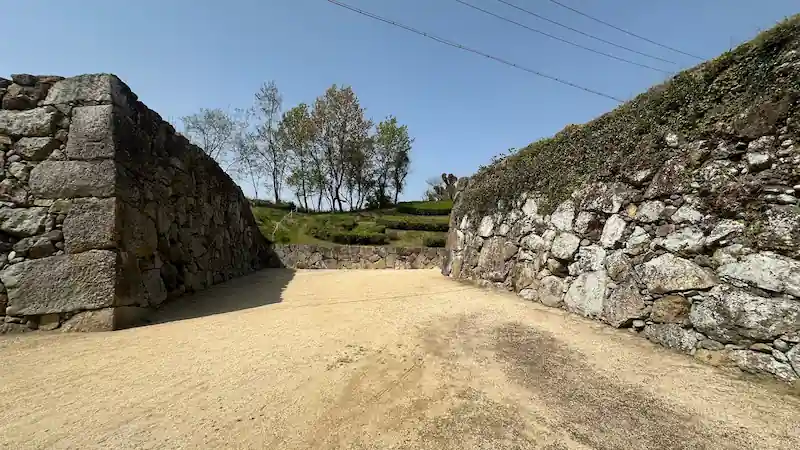
⭐ Recommended Rating
Historical Significance: ☆☆
Visual Appeal: ☆☆
Experiential Value: ☆
The Shimizu Gate (清水門) was one of the key entrances to Himeji Castle, strategically located along the Senba River. Its name, meaning “Pure Water Gate,” is derived from the nearby renowned spring, Sagi-no-Shimizu (“Heron’s Spring”), which supplied water to adjacent reservoirs and wells. The gate’s architecture featured a complex defensive design: an outer west-facing koraimon gate with auxiliary roofs leading into an inner courtyard, followed by a larger south-facing inner gate topped with a watchtower. This arrangement forced attackers to slow down and change direction, enhancing the castle’s defense. A guardhouse was situated just beyond the inner gate to monitor access. Although the original structures no longer exist, remnants of stone walls and the reconstructed well house remain, offering visitors a glimpse into the castle’s historical defenses.
| Year Built | Early 17th century |
|---|---|
| Builder | Ikeda Terumasa |
| Structure & Features | Double-gated entrance with watchtower and guardhouse; adjacent to Sagi-no-Shimizu well |
| Restoration History | Well house reconstructed based on historical records |
| Current Status | Stone foundations and reconstructed well house remain |
| Destruction or Damage | Original gate structures dismantled during the Meiji period |
| Cultural Designation | Part of Himeji Castle, a UNESCO World Heritage Site |
🗺 Address:68 Honmachi, Himeji, Hyogo Prefecture, Japan
🚶 Access
Approx. 1-minute walk (23m) from Sagi-no-Shimizu (鷺の清水)
⏳ Suggested Visit Duration
Quick Highlights: approx. 10 minutes
In-Depth Exploration: approx. 20 minutes
📍 Highlights
- Stone Foundations: Observe the remaining base structures that outline the gate’s original layout.
- Reconstructed Well House: Explore the replica of the well house covering Sagi-no-Shimizu, reflecting historical design.
- Scenic Surroundings: Enjoy the tranquil environment near the Senba River, especially picturesque during cherry blossom season.
📌 Trivia
- Strategic Design: The gate’s angled layout was intended to impede direct enemy advances, enhancing defensive capabilities.
- Historical Anecdote: Local folklore includes a tale of a tea ceremony contest between Himeji’s lord and a Kyoto merchant, where water from Sagi-no-Shimizu was deemed equal in quality to Kyoto’s famed springs.
- Modern Utilization: Post-Meiji Restoration, water from Sagi-no-Shimizu was used to supply the local military garrison and later served as a municipal water source until the 1970s.
Otokoyama Haisuiike Park (Water Reservoir Park)
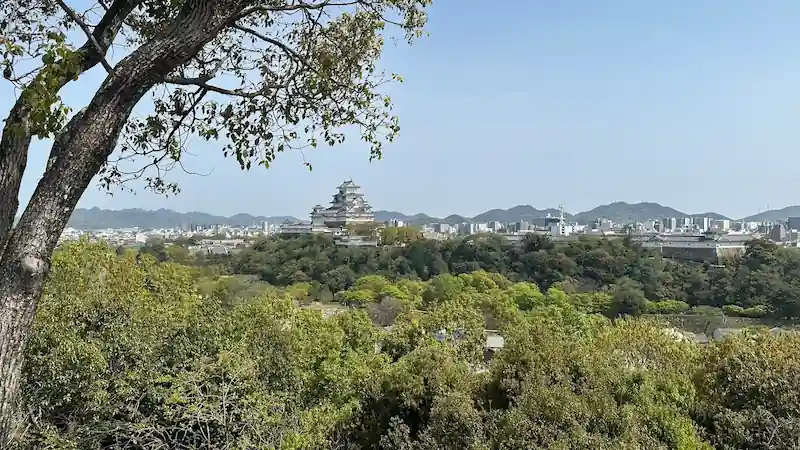
⭐ Recommended Rating
Historical Significance: ☆
Visual Appeal: ☆☆☆
Experiential Value: ☆☆
Perched atop the 57.5-meter-high Otokoyama hill, Otokoyama Haisuiike Park offers one of the most breathtaking panoramic views of Himeji Castle. Accessible via a steep climb of approximately 198 steps, visitors are rewarded with a vantage point that captures the castle’s main keep and its three smaller towers in a picturesque setting. The park is also home to the Otokoyama Hachimangu Shrine, dedicated to the guardian deity of Himeji Castle, adding a spiritual dimension to the visit. Recognized as one of the “Ten Scenic Views of Himeji Castle,” this spot is particularly popular among photographers and those seeking a tranquil retreat with a historical backdrop.
| Item | Content |
|---|---|
| Year Built | Unknown (developed as a park in the 20th century) |
| Builder | Unknown |
| Structure/Features | Located atop Otokoyama hill, approximately 57 meters high, northwest of Himeji Castle. The park features a water reservoir and offers panoramic views of Himeji Castle. It is also home to Otokoyama Hachimangū Shrine, dedicated to the guardian deity of the castle. |
| Renovation/Restoration | None |
| Current Status | Open to the public; accessible 24 hours |
| Destruction/Damage | None |
| Cultural Property Designation | None |
| Remarks | Recognized as one of the “Ten Scenic Views of Himeji Castle.” Visitors can reach the summit by climbing approximately 198 steps, rewarding them with stunning views, especially at sunrise and sunset. |
🗺 Address: 37-3 Yamanoicho, Himeji, Hyogo 670-0021, Japan
🚶 Access
Approx. 6-minute walk (400m) from Shimizu Gate Ruins (清水門跡)
⏳ Suggested Visit Time
Quick Stop: Approx. 20 minutes
In-Depth Exploration: Up to 1 hour
📍 Highlights
- Panoramic Views: Offers one of the best vantage points to view Himeji Castle in its entirety, especially stunning during sunrise and sunset.
- Otokoyama Hachimangu Shrine: A serene shrine dedicated to the castle’s guardian deity, providing cultural and spiritual insights.
- Seasonal Scenery: The park is adorned with cherry blossoms in spring and vibrant foliage in autumn, enhancing its natural beauty.
📌 Trivia
- Photographer’s Paradise: Recognized as one of the “Ten Scenic Views of Himeji Castle,” it’s a favored spot for capturing the castle against various backdrops.
- Steep Ascent: The climb involves approximately 198 steps, making it a moderate challenge for visitors, but the view at the top is deemed well worth the effort.
- Night Illumination: The park offers a unique perspective of the illuminated Himeji Castle at night, providing a magical experience for evening visitors.
Otokoyama Senhime Tenmangū (男山千姫天満宮)
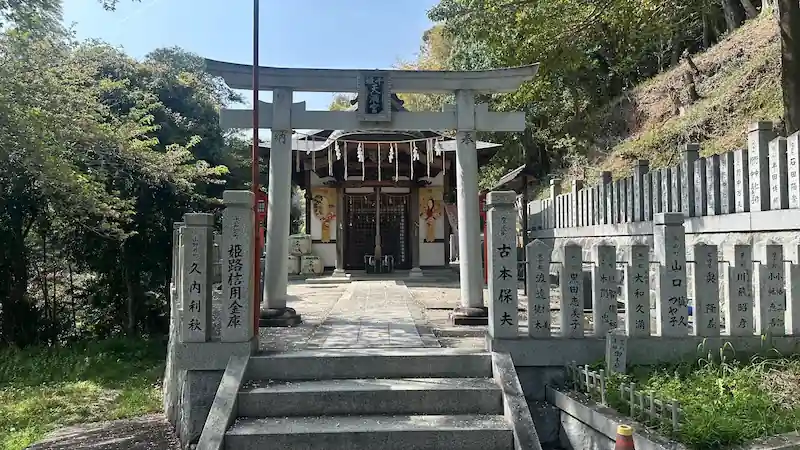
⭐ Recommended Rating
Historical Significance: ☆☆
Visual Appeal: ☆☆
Experiential Value: ☆
Perched on the slopes of Otokoyama, northwest of Himeji Castle, Otokoyama Senhime Tenmangū is a modest yet historically significant shrine. Established in 1623 by Princess Senhime, granddaughter of Tokugawa Ieyasu, the shrine was dedicated to Tenman Daijizai Tenjin (Sugawara no Michizane), reflecting her deep faith and desire for her family’s prosperity. Senhime, having remarried Honda Tadatoki and moved to Himeji Castle, is traditionally believed to have commissioned the shrine so she could offer prayers from the castle’s Nishi-no-Maru (western bailey), with the shrine’s orientation allowing for direct line-of-sight worship. The current structure, rebuilt in 2002, features elegant karahafu (curved gable) architecture, and the site remains a place of reverence and tranquility.
| Year Built | 1623 |
|---|---|
| Founder | Princess Senhime |
| Structure & Features | East-facing shrine with karahafu architecture; dedicated to Tenman Daijizai Tenjin |
| Restoration History | Reconstructed in 2002 to commemorate its historical significance |
| Current Status | Active shrine with regular visitors and maintained grounds |
| Destruction or Damage | Original structure no longer exists; current building is a faithful reconstruction |
| Cultural Designation | Part of the Himeji Castle area, a UNESCO World Heritage Site |
🗺 Address:1-3 Yamanoi-cho, Himeji, Hyogo Prefecture, Japan
🚶 Access
Approx. 2-minute walk (120m) from Himeji 10 Scenic Sites (World Heritage site)
⏳ Suggested Visit Duration
Quick Highlights: approx. 10 minutes
In-Depth Exploration: approx. 20 minutes
📍 Highlights
- Architectural Design: Admire the elegant karahafu gable and traditional shrine aesthetics.
- Historical Connection: Learn about Senhime’s life and her contributions to Himeji’s cultural heritage.
- Scenic Views: Enjoy panoramic views of Himeji Castle from the shrine’s elevated position.
📌 Trivia
- Dedication: Senhime dedicated the shrine to Tenman Daijizai Tenjin, reflecting her scholarly aspirations and devotion.
- Orientation: The shrine was constructed facing east to allow Senhime to worship from the castle’s Nishi-no-Maru.
- Reconstruction: The current structure, rebuilt in 2002, commemorates the shrine’s historical and cultural significance.
Sengoku no Komichi (千姫の小径)

⭐ Recommended Rating
Historical Significance: ☆☆
Visual Appeal: ☆☆☆
Experiential Value: ☆☆☆
Sengoku no Komichi, or “Princess Sen’s Path,” is a picturesque walking trail situated between the western inner moat and the Semba River, stretching north to south adjacent to Himeji Castle. The path is adorned with cherry blossoms and maple trees, offering a serene environment that reflects the changing seasons. The name honors Princess Sen (Senhime), the granddaughter of Tokugawa Ieyasu, who spent part of her life at Himeji Castle. While the path itself is a modern addition, it provides a tranquil setting that complements the historical ambiance of the castle grounds.
| Year Established | Modern era (exact year not specified) |
|---|---|
| Founder | City of Himeji |
| Structure & Features | Earthen path lined with cherry and maple trees; flanked by water features |
| Restoration History | Regular maintenance by the city; specific restoration details not specified |
| Current Status | Open to the public as a scenic walking trail |
| Destruction or Damage | Not applicable |
| Cultural Designation | Part of the Himeji Castle area, a UNESCO World Heritage Site |
🗺 Address:Adjacent to Koko-en Garden, Himeji, Hyogo Prefecture, Japan
🚶 Access
Approx. 5-minute walk (350m) from Otokoyama Senhime Tenmangū (男山千姫天満宮)
⏳ Suggested Visit Duration
Quick Highlights: approx. 15 minutes
In-Depth Exploration: approx. 30 minutes
📍 Highlights
- Seasonal Scenery: Experience the vibrant cherry blossoms in spring and colorful foliage in autumn.
- Tranquil Atmosphere: Enjoy a peaceful walk alongside the water, away from the bustling castle areas.
- Photographic Opportunities: Capture stunning views of the castle framed by seasonal flora.
📌 Trivia
- Princess Sen’s Legacy: The path is named in honor of Princess Sen, reflecting her historical connection to Himeji Castle.
- Wildlife Spotting: The area is known for sightings of white herons, aligning with the castle’s nickname, “White Heron Castle.”
- Local Events: The path is a popular spot during local festivals and seasonal events, offering a cultural experience.
Ichinohashi Gate Ruins (市ノ橋門跡)
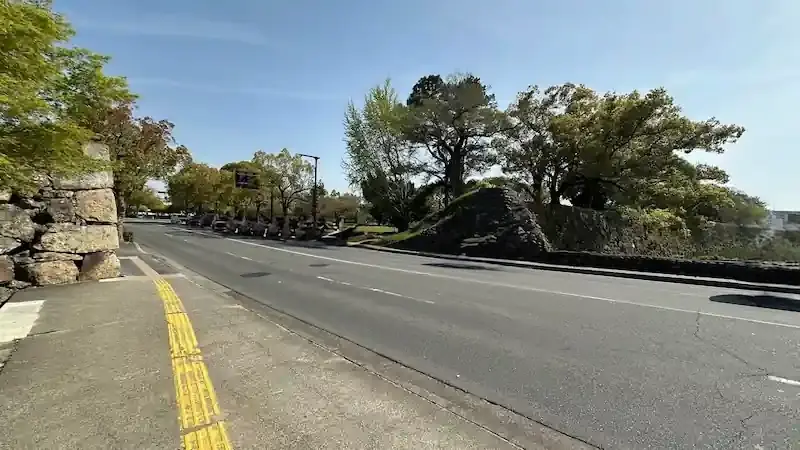
⭐ Recommended Rating
Historical Significance: ☆☆
Visual Appeal: ☆☆
Experiential Value: ☆
The Ichinohashi Gate (市ノ橋門) once served as a crucial western entrance to Himeji Castle, connecting the castle grounds to the merchant and artisan districts across the Senba River. The name “Ichinohashi” translates to “Market Bridge Gate,” reflecting its role as a gateway between the castle and the bustling town. The gate featured a complex defensive design: an outer gate facing west with a protruding structure over the moat, leading into an inner courtyard, and then an inner gate set at an angle to the outer gate. This layout was intended to slow down and expose attackers. Above the inner gate stood a storehouse, and a guardhouse was situated just beyond it. Although the original structures no longer exist, remnants of stone walls and the reconstructed well house remain, offering visitors a glimpse into the castle’s historical defenses.
| Year Built | Early 17th century |
|---|---|
| Builder | Ikeda Terumasa |
| Structure & Features | Double-gated entrance with angled inner gate; adjacent to Semba River |
| Restoration History | Stone wall repairs conducted in the late 20th century |
| Current Status | Gate structures lost; stone base remains visible |
| Destruction or Damage | Original wooden structures dismantled over time |
| Cultural Designation | Part of Himeji Castle, a UNESCO World Heritage Site |
🗺 Address:68 Honmachi, Himeji, Hyogo Prefecture, Japan
🚶 Access
Approx. 7-minute walk (500m) from Sengoku no Komichi (千姫の小径)
⏳ Suggested Visit Duration
Quick Highlights: approx. 10 minutes
In-Depth Exploration: approx. 20 minutes
📍 Highlights
- Stone Foundations: Observe the remaining base structures that outline the gate’s original layout.
- Historical Significance: Learn about the gate’s role in connecting the castle to the merchant district.
- Scenic Surroundings: Enjoy the tranquil environment near the Senba River, especially picturesque during cherry blossom season.
📌 Trivia
- Strategic Design: The gate’s angled layout was intended to impede direct enemy advances, enhancing defensive capabilities.
- Artisan District: The area across the gate was known as Zaimoku-machi (“lumber district”), home to woodworkers and carpenters.
- Falconers’ Access: Falconers who tended the daimyo’s hunting birds used this gate to access the castle.
Statue of Princess Sen (Senhime)
⭐ Recommended Rating
Historical Significance: ☆☆
Visual Appeal: ☆☆
Experiential Value: ☆

The statue of Princess Sen, affectionately known as Senhime, stands gracefully near Himeji Castle, commemorating her significant role in the castle’s history. As the granddaughter of Tokugawa Ieyasu and the wife of Honda Tadatoki, the lord of Himeji Castle, Princess Sen’s life was marked by both privilege and tragedy. After surviving the fall of Osaka Castle, she remarried and moved to Himeji, where she became deeply involved in the cultural and social affairs of the domain. The statue captures her poised demeanor and serves as a tribute to her resilience and influence during the early Edo period. Visitors often find the statue a poignant reminder of the personal stories intertwined with the grandeur of Himeji Castle.
| Item | Content |
|---|---|
| Year Built | 1997 (Heisei 9) |
| Builder | Senhime Tenmangū Shrine Committee |
| Structure/Features | Bronze statue facing the direction of Otokoyama and Senhime Tenmangū Shrine, where Princess Sen is believed to have prayed. Located near the remains of Ichinohashi Gate, aligned with the Nishinomaru Hyakken Rōka (long corridor). |
| Renovation/Restoration | None |
| Current Status | Still standing |
| Destruction/Damage | None |
| Cultural Property Designation | None |
| Remarks | Includes an informational plaque displaying a poem exchange between Princess Sen and her husband Honda Tadatoki. Located near the west side of Himeji Castle. |
🗺 Address: 68 Honmachi, Himeji, Hyogo Prefecture
🚶 Access
Approx. 2-minute walk (120m) from Ichinohashi Gate Ruins (市ノ橋門跡)
⏳ Suggested Visit Time
Quick Stop: Approx. 10 minutes
In-Depth Exploration: Up to 30 minutes
📍 Highlights
- Historical Significance: Offers insight into the life of Princess Sen and her connection to Himeji Castle.
- Artistic Merit: The bronze craftsmanship captures the elegance and poise of a noblewoman from the Edo period.
- Photographic Opportunity: The statue, set against the backdrop of Himeji Castle, provides a picturesque scene for visitors.
📌 Trivia
- Resilience Personified: Princess Sen’s life story is one of survival and adaptation, making her a symbol of strength in Japanese history.
- Cultural Influence: Beyond her noble status, she was known for promoting cultural activities and supporting the arts in Himeji.
- Legacy: Her story has been depicted in various literary works and dramas, highlighting her enduring legacy in Japanese culture.
Kōkoen Garden
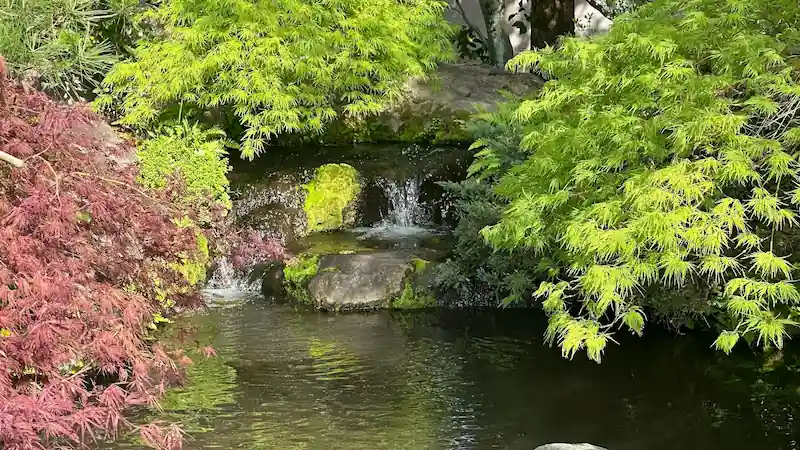
⭐ Recommended Rating
Historical Significance: ☆
Visual Appeal: ☆☆☆
Experiential Value: ☆☆☆
🏛 Overview
Kōkoen Garden is a meticulously designed Japanese garden located on the former site of the western residence (Nishi O-yashiki) of Himeji Castle. Opened in 1992 to commemorate the 100th anniversary of Himeji’s incorporation as a city, the garden spans 3.5 hectares (approximately 0.75 Tokyo Domes) and consists of nine distinct gardens arranged in a traditional kaiyū-shiki (strolling-style) layout. It elegantly conveys the atmosphere of the old castle town and the aesthetics of samurai culture.
The garden’s name, “Kōkoen,” is said to derive from either the Meiji-era military leader Kawai Yoshifuru—descendant of a Himeji retainer—or from the phrase meaning “to cherish the past.” Either way, it embodies a deep reverence for history.
The design incorporates a variety of classical Japanese gardening techniques, including tea gardens, pond-centered stroll gardens, and miniature mountains with forest streams. It also creatively incorporates views of Himeji Castle’s white walls and stone foundations into its scenic backdrop. Kōkoen is popular not only with tourists but also for photo shoots, kimono experiences, and as a filming location.
| Item | Content |
|---|---|
| Year Built | 1992 |
| Builder | Himeji City |
| Structure/Features | Comprises nine distinct Edo-period style gardens, including the Garden of the Lord’s Residence, Tea Ceremony Garden, Bamboo Garden, and Flower Garden. Features traditional elements like mud walls (tsuijibei), wooden gates (Yashikimon, Nagayamon), and a sukiya-style tea house (Souju-an). |
| Renovation/Restoration | Ongoing maintenance; specific restoration details not publicly documented. |
| Current Status | Open to the public; accessible with facilities like Souju-an Tea House and Kassui-ken Restaurant. |
| Destruction/Damage | None |
| Cultural Property Designation | None |
| Remarks | Constructed on the former site of the feudal lord’s west residence (Nishi-Oyashiki) to commemorate Himeji City’s 100th anniversary. The garden’s name honors “Kōko-dō,” a provincial school established by the Sakai clan in 1692. |
🗺 Address:
68 Honmachi, Himeji City, Hyogo Prefecture (West of Himeji Castle)
🚶 Access:
Approx. 5-minute walk (350m) from Princess Sen Sedentary Statue
⏳ Recommended Visit Time:
- Quick stroll: Approx. 30 minutes (selected areas)
- Full experience: Approx. 60 minutes (includes all gardens and tea room visit)
📍 Highlights
🔹 Nagare-no-Hiraniwa Garden: A spacious central garden with a large pond and a picture-perfect view of Himeji Castle framed by stone bridges.
🔹 Tea Garden and “Sōjuan” Teahouse: Experience traditional tea culture in an authentic teahouse, with seasonal matcha service available (fee applies).
🔹 Seasonal Delights:
🌸 Spring – Cherry blossoms and fresh greenery reflecting on water
🍁 Autumn – Fiery foliage illuminated in the evening (night light-ups)
❄️ Winter – Snow-dusted kare-sansui dry landscapes offer serene beauty
📌 Trivia
- Hidden History: The garden sits on land that once hosted the lord’s residence and senior retainers’ homes. Its current layout preserves the traditional zoning of the former castle town.
- Insider Tip: Some believe that stones used in the garden paths were repurposed from castle renovations—though this has not been officially confirmed. See if you can spot them!
- Famous Connection: Film director Nobuhiko Obayashi called Kōkoen “a garden where time transcends eras,” using it as a backdrop for period films.
Remains of South Segakushi gate
⭐ Recommended Rating
Historical Significance: ☆☆☆
Visual Appeal: ☆☆
Experiential Value: ☆
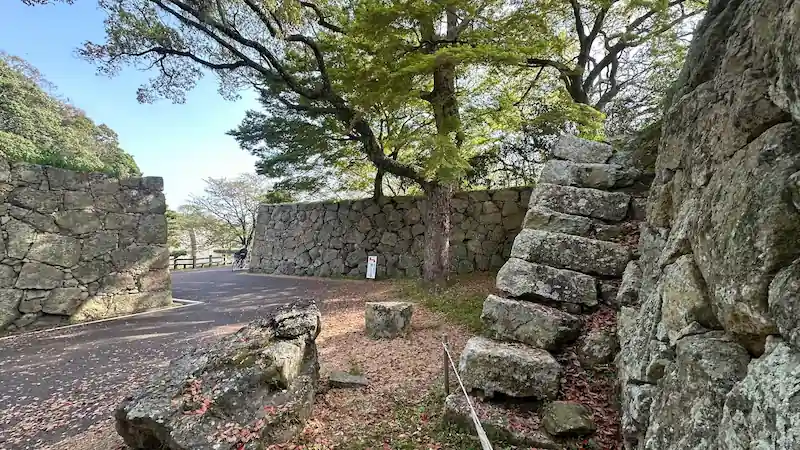
The South Segakushi Gate, once a vital component of Himeji Castle’s intricate defensive network, now exists only in remnants. Originally serving as one of the numerous gates designed to confuse and slow down potential invaders, this gate was strategically placed to enhance the castle’s security. Today, visitors can observe the stone foundations that hint at its past significance. While the gate itself no longer stands, the remaining structures offer a glimpse into the architectural ingenuity of the Edo period. Informational signage at the site provides context, allowing visitors to appreciate the historical importance of this location within the castle complex.
| Item | Content |
|---|---|
| Year Built | Early 17th century (Edo period) |
| Builder | Ikeda Terumasa |
| Structure/Features | One of the concealed gates (kakure-mon) designed for surprise attacks and secret movements within the castle. Strategically placed to allow defenders to launch surprise counterattacks. |
| Renovation/Restoration | None |
| Current Status | Ruins remain; traces of the stone foundations remain, though difficult to identify without context. |
| Destruction/Damage | Gate structure no longer exists. |
| Cultural Property Designation | None |
| Remarks | Part of the intricate defensive layout of Himeji Castle, contributing to its maze-like design intended to confuse and slow down attackers. |
🗺 Address: 68 Honmachi, Himeji, Hyogo Prefecture
🚶 Access
Approx. 5-minute walk (400m) from Kōkoen Garden
⏳ Suggested Visit Time
Quick Stop: Approx. 10 minutes
In-Depth Exploration: Up to 30 minutes
📍 Highlights
- Historical Foundations: Observe the stone base that once supported the South Segakushi Gate, offering insight into the castle’s defensive architecture.
- Informational Signage: On-site panels provide historical context and details about the gate’s role within the castle complex.
- Proximity to Other Sites: Located near other significant remnants, allowing for a comprehensive exploration of Himeji Castle’s lesser-known features.
📌 Trivia
- Defensive Strategy: The gate was part of a complex maze designed to confuse attackers, showcasing the strategic planning of Edo-period castle construction.
- Architectural Techniques: The remaining stone foundations reflect the construction methods and materials used during the early 17th century.
- Photographic Opportunity: While modest, the site offers unique angles for photography enthusiasts interested in historical architecture.
Kuruma Gate Ruins (車門跡)
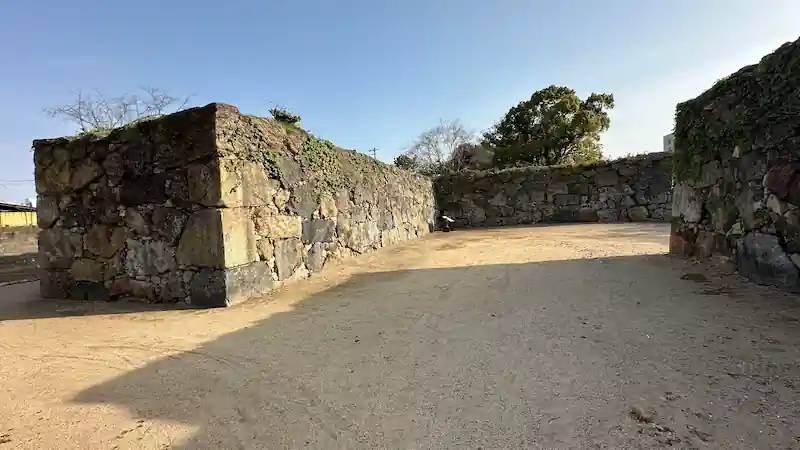
⭐ Recommended Rating
Historical Significance: ☆☆
Visual Appeal: ☆☆
Experiential Value: ☆
The Kuruma Gate (車門) was a significant western entrance to Himeji Castle, strategically positioned along the Semba River and the historic Saigoku Kaidō highway. The name “Kuruma,” meaning “carriage,” reflects its role in facilitating the transport of goods and materials into the castle. The gate featured a unique double-masugata (square enclosure) design, enhancing its defensive capabilities. The outer gate faced west, connected by a wooden bridge over the moat, leading into a narrow courtyard. This was followed by a middle gate facing south, and then a larger inner gate topped with a watchtower. Additionally, a small guardhouse was situated near the inner gate. Notably, the gate included a waterside entrance from the Semba River, allowing for direct access by boat, underscoring its importance in both land and water transportation. Although the original structures no longer exist, remnants of stone walls and the layout of the gate’s foundations remain, offering insights into the castle’s historical defenses.
| Year Built | Early 17th century |
|---|---|
| Builder | Ikeda Terumasa |
| Structure & Features | Double-masugata gate with watchtower and waterside entrance; connected to Saigoku Kaidō and Semba River |
| Restoration History | Stone wall repairs conducted in the late 20th century |
| Current Status | Gate structures lost; stone base and layout remain visible |
| Destruction or Damage | Original wooden structures dismantled over time |
| Cultural Designation | Part of Himeji Castle, a UNESCO World Heritage Site |
🗺 Address:68 Honmachi, Himeji, Hyogo Prefecture, Japan
🚶 Access
Approx. 8-minute walk (600m) from the Remains of South Segakushi gate
⏳ Suggested Visit Duration
Quick Highlights: approx. 10 minutes
In-Depth Exploration: approx. 20 minutes
📍 Highlights
- Stone Foundations: Observe the remaining base structures that outline the gate’s original layout.
- Historical Significance: Learn about the gate’s role in connecting the castle to the Saigoku Kaidō and facilitating transportation.
- Scenic Surroundings: Enjoy the tranquil environment near the Semba River, especially picturesque during cherry blossom season.
📌 Trivia
- Unique Design: The gate’s double-masugata layout was uncommon, enhancing its defensive capabilities.
- Transportation Hub: The gate facilitated both land and water transportation, underscoring its strategic importance.
- Connection to Princess Sen: The nearby path, “Sengoku no Komichi,” is named in honor of Princess Sen, reflecting her historical connection to Himeji Castle.
Uzumi Gate Ruins (埋門跡)

⭐ Recommended Rating
Historical Significance: ☆☆
Visual Appeal: ☆☆
Experiential Value: ☆
The Uzumi Gate (埋門), translating to “Buried Gate,” was a strategically designed entrance on the southwestern side of Himeji Castle. Constructed in the 1620s, approximately two decades after Ikeda Terumasa expanded the castle to its current scale, the gate was integrated into an existing stone wall by creating an opening, hence its name. Unlike other gates, the Uzumi Gate lacked a watchtower directly above it; instead, a two-story turret and guard station were positioned just west of the gate, overseeing the southwestern corner of the castle and the Saigoku Kaidō highway. This configuration allowed defenders to monitor and control access effectively. The gate featured both an outer and inner gate, both facing south, with a soil bridge over the inner moat facilitating passage. Today, while the original structures no longer exist, the stone foundations remain, offering insights into the castle’s defensive architecture.
| Year Built | 1620s |
|---|---|
| Builder | Ikeda Terumasa |
| Structure & Features | Integrated into existing stone wall; lacked overhead watchtower; adjacent turret and guard station |
| Restoration History | Stone wall repairs conducted in the late 20th century |
| Current Status | Gate structures lost; stone base remains visible |
| Destruction or Damage | Original wooden structures dismantled over time |
| Cultural Designation | Part of Himeji Castle, a UNESCO World Heritage Site |
🗺 Address:68 Honmachi, Himeji, Hyogo Prefecture, Japan
🚶 Access
Approx. 2-minute walk (150m) from Kuruma Gate Ruins (車門跡)
⏳ Suggested Visit Duration
Quick Highlights: approx. 10 minutes
In-Depth Exploration: approx. 20 minutes
📍 Highlights
- Stone Foundations: Observe the remaining base structures that outline the gate’s original layout.
- Historical Significance: Learn about the gate’s role in connecting the castle to the Saigoku Kaidō and facilitating transportation.
- Scenic Surroundings: Enjoy the tranquil environment near the Semba River, especially picturesque during cherry blossom season.
📌 Trivia
- Unique Design: The gate’s integration into an existing stone wall was a strategic choice to enhance defense while maintaining the wall’s integrity.
- Transportation Hub: The adjacent turret allowed for monitoring of the Saigoku Kaidō, a vital route connecting Kyoto to western Japan.
- Modern Access: Today, visitors can explore the remnants of the gate and gain insights into the castle’s defensive strategies.
Kumataka-mon Gate Site
⭐ Recommended Rating
Historical Significance: ☆☆
Visual Appeal: ☆
Experiential Value: ☆

The Kumataka-mon Gate, named after the mountain hawk-eagle (kumataka), once stood as a significant entry point within Himeji Castle’s complex defensive network. While the exact reason for its naming remains uncertain, one theory suggests that the castle’s lord kept hunting birds nearby, linking the gate to the majestic raptor. Today, only the stone foundations of the gate remain, offering a glimpse into the architectural ingenuity of the Edo period. Notably, the earth-and-stone bridge in front of the gate functioned like a dam, helping to maintain the water level of the moat. This bridge could be flooded, allowing water to spill over and raise the water level on its other side, showcasing the strategic integration of infrastructure and defense mechanisms in the castle’s design.
| Item | Content |
|---|---|
| Year Built | Early 17th century (Edo period) |
| Builder | Ikeda Terumasa |
| Structure/Features | Named after the “kumataka” (mountain hawk-eagle), possibly due to falconry practices nearby. Served as a ceremonial gate for incoming retainers; departing retainers used a different route. Featured an earth-and-stone bridge functioning as a dam to regulate moat water levels. |
| Renovation/Restoration | None |
| Current Status | Ruins remain; stone foundations are visible. |
| Destruction/Damage | Gate structure no longer exists. |
| Cultural Property Designation | None |
| Remarks | Played a role in controlling access to the castle town and managing water levels in the moat system. |
🗺 Address: 68 Honmachi, Himeji, Hyogo Prefecture
🚶 Access
Approx. 4-minute walk (300m) from Uzumi Gate Ruins (埋門跡)
⏳ Suggested Visit Time
Quick Stop: Approx. 10 minutes
In-Depth Exploration: Up to 30 minutes
📍 Highlights
- Stone Foundations: Observe the remaining base structures that once supported the Kumataka-mon Gate, providing insight into Edo-period construction techniques.
- Informational Signage: On-site panels offer historical context and details about the gate’s role within the castle complex.
- Adjacent Earth-and-Stone Bridge: Examine the bridge that functioned as a dam, illustrating the strategic integration of infrastructure and defense mechanisms in the castle’s design.
📌 Trivia
- Unique Naming: The gate’s name, derived from the mountain hawk-eagle (kumataka), adds a layer of cultural intrigue, possibly reflecting the lord’s interest in falconry.
- Engineering Marvel: The adjacent bridge’s dual function as a dam showcases the advanced engineering and strategic planning employed in Himeji Castle’s design.
- Photographic Opportunity: While modest, the site offers unique angles for photography enthusiasts interested in historical architecture.
Nakanomon Gate Site
⭐ Recommended Rating
Historical Significance: ☆☆
Visual Appeal: ☆
Experiential Value: ☆
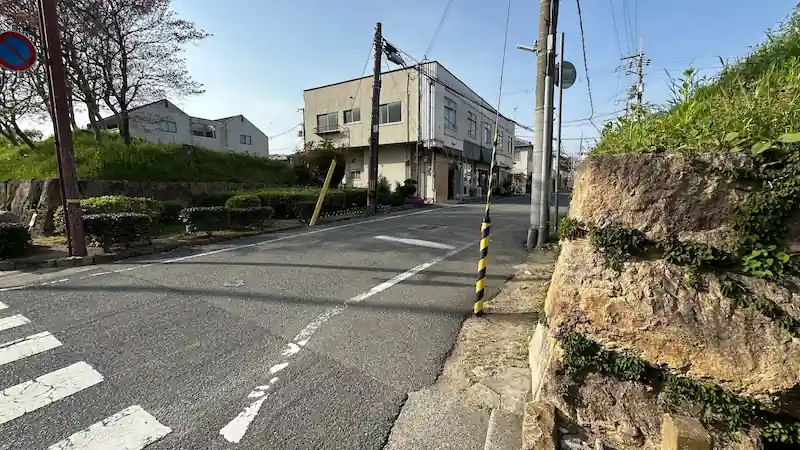
The Nakanomon Gate, or “Middle Gate,” once stood along the southern approach to Himeji Castle, serving as a key checkpoint between the outer defenses and the castle proper. Positioned strategically near the old Saigoku Highway, this gate controlled access for both commoners and high-ranking visitors. At night, the gate was closed to the general public, and only physicians were granted emergency access after sundown—a detail that underscores its importance as a security feature.
Though the gate structure no longer exists, remnants of its stone base remain visible, offering visitors a tangible connection to the defensive ingenuity of the Edo period. Near the gate’s location was also an official noticeboard, where domain-wide proclamations were posted for residents—making this area not just a physical gateway, but also a hub of civic communication. Today, signage at the site helps modern visitors understand the gate’s historical role in the daily and political life of Himeji’s castle town.
| Item | Content |
|---|---|
| Year Built | Early 17th century (Edo period) |
| Builder | Ikeda Terumasa |
| Structure/Features | Known as the “Middle Gate,” it stood at the midpoint of the southern moat, serving as the primary gate in the outer fortifications. It connected the Otemon Gate to the inner areas of the castle and was situated near the intersection of the castle road and the Saikoku Kaido trade route. Official domain proclamations were posted nearby. |
| Renovation/Restoration | None |
| Current Status | Ruins remain; stone foundations are visible. |
| Destruction/Damage | Gate structure no longer exists. |
| Cultural Property Designation | None |
| Remarks | The gate was closed at night, with exceptions made only for doctors on emergency calls. It was part of the route used by high-ranking visitors entering the castle. |
🗺 Address: 68 Honmachi, Himeji, Hyogo Prefecture
🚶 Access
Approx. 4-minute walk (300m) from Kumataka-mon Gate Site
⏳ Suggested Visit Time
Quick Stop: Approx. 10 minutes
In-Depth Exploration: Up to 30 minutes
📍 Highlights
- Stone Remnants: View the preserved stone base of the former gate, offering a direct link to Edo-era fortification techniques.
- Historical Signage: Informational panels provide rich context on the gate’s role and historical surroundings.
- Crossroads of History: Located at a junction with the old Saigoku Highway, the site served both military and civic functions.
📌 Trivia
- Night Closure Policy: After dark, passage through the gate was restricted to medical emergencies, typically doctors on urgent calls.
- Proclamation Board: Government orders and domain announcements were posted at a nearby noticeboard for public view.
- Gateway to the Castle Town: As a key point on the route from the town center to the inner castle, the gate served as a ceremonial and practical entrance for important visitors.
Nakabori (Middle Moat) Remains (中濠跡)

⭐ Recommended Rating
Historical Significance: ☆☆
Visual Appeal: ☆☆
Experiential Value: ☆
The Nakabori (Middle Moat) was an integral part of Himeji Castle’s triple moat defense system, encircling the Ninomaru (Second Bailey) and serving as a protective barrier for the samurai residences and key administrative areas. Constructed during the early 17th century under the supervision of Ikeda Terumasa, the moat exemplified advanced defensive architecture of the Edo period. Over time, urban development led to the partial filling of the moat, especially during the early Showa era when National Route 2 was constructed over its path. Despite these changes, sections of the moat and accompanying earthworks remain visible today, offering insights into the castle’s historical landscape. Visitors can explore these remnants along walking paths that trace the original course of the moat, providing a tangible connection to the past.
| Year Built | Early 17th century |
|---|---|
| Builder | Ikeda Terumasa |
| Structure & Features | Encircled the Ninomaru; part of a triple moat system with earthen embankments |
| Restoration History | Partial preservation efforts in the late 20th century |
| Current Status | Sections remain visible; other parts filled in for urban development |
| Destruction or Damage | Partially filled during early Showa era for road construction |
| Cultural Designation | Part of Himeji Castle, a UNESCO World Heritage Site |
🗺 Address:68 Honmachi, Himeji, Hyogo Prefecture, Japan
🚶 Access
Approx. 1-minute walk (66m) from Nakanomon Gate Site
⏳ Suggested Visit Duration
Quick Highlights: approx. 15 minutes
In-Depth Exploration: approx. 30 minutes
📍 Highlights
- Remnant Sections: Explore preserved segments of the moat and accompanying earthworks.
- Historical Markers: Informational plaques provide context and historical background.
- Scenic Walkways: Enjoy tranquil paths that trace the original course of the moat.
📌 Trivia
- Urban Transformation: Parts of the Nakabori were filled in to accommodate National Route 2 during the early Showa era.
- Defensive Strategy: The triple moat system exemplified advanced military architecture of the Edo period.
- Community Engagement: Local efforts have preserved sections of the moat, highlighting community dedication to cultural heritage.
Sōja Gate Ruins (総社門跡)
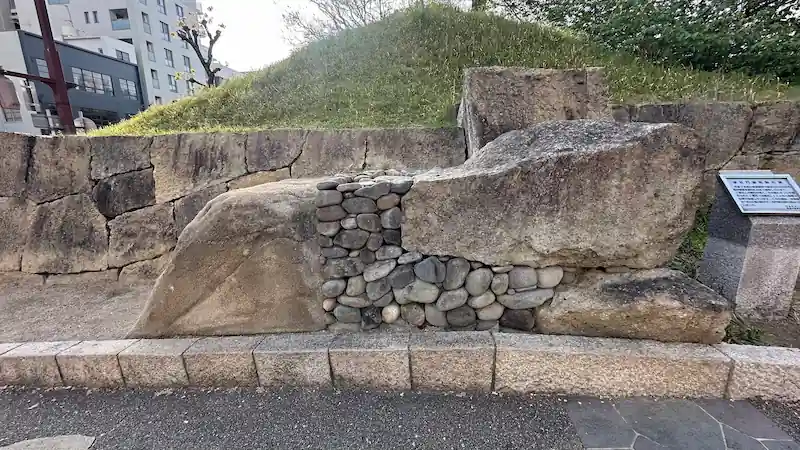
⭐ Recommended Rating
Historical Significance: ☆☆
Visual Appeal: ☆☆
Experiential Value: ☆
The Sōja Gate (総社門) was one of the five main gates constructed on the southern side of Himeji Castle’s Naka-kuruwa (Middle Bailey). Its name derives from its proximity to the west gate of the Harima Sōja Shrine, located just northeast of the gate. Built in the early 17th century under the supervision of Ikeda Terumasa, the gate featured a masugata (square enclosure) design, consisting of an outer gate facing south and an inner gate facing east. This layout was intended to trap and expose attackers to crossfire from multiple angles. A guardhouse was also situated nearby to monitor those entering and exiting the castle. Although the original wooden structures no longer exist, remnants of stone walls and the layout of the gate’s foundations remain, offering insights into the castle’s defensive architecture.
| Year Built | Early 17th century |
|---|---|
| Builder | Ikeda Terumasa |
| Structure & Features | Masugata (square enclosure) with outer and inner gates; adjacent guardhouse |
| Restoration History | Excavations conducted in 1984 and 1995 revealed stone walls and a culvert |
| Current Status | Gate structures lost; stone base remains visible |
| Destruction or Damage | Original wooden structures dismantled over time; stone walls partially removed for road construction |
| Cultural Designation | Part of Himeji Castle, a UNESCO World Heritage Site |
🗺 Address:68 Honmachi, Himeji, Hyogo Prefecture, Japan
🚶 Access
Approx. 4-minute walk (300m) from Nakabori (Middle Moat) Remains (中濠跡)
⏳ Suggested Visit Duration
Quick Highlights: approx. 10 minutes
In-Depth Exploration: approx. 20 minutes
📍 Highlights
- Stone Foundations: Observe the remaining base structures that outline the gate’s original layout.
- Historical Significance: Learn about the gate’s role in connecting the castle to the Harima Sōja Shrine and its defensive features.
- Scenic Surroundings: Enjoy the tranquil environment near the former moat, especially picturesque during cherry blossom season.
📌 Trivia
- Unique Design: The gate’s masugata layout was designed to trap and expose attackers to crossfire from multiple angles.
- Strategic Location: Positioned to protect the southern approach to the castle, monitoring access from the Saigoku Kaidō highway.
- Modern Transformation: Parts of the stone walls were removed to accommodate the construction of National Route 2 during the early Showa era.




comment